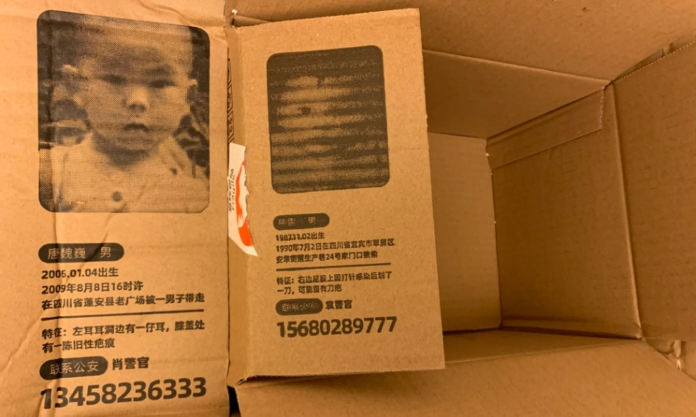Had any bulky deliveries recently? If so, and had you purchased from one particular online retailer, then you may well have noticed the latest innovation in attempts to locate missing children in China; printing their essential information on the inside of the box.
The new initiative is down to that behemoth of online commerce in China, Tmall, formerly Taobao Mall. With millions of boxes being sent out every day, the system theoretically punches sufficiently high to be able to make a dent in the numbers of missing children.
On the box, a photo of a missing child is accompanied by their name; gender; date of birth; date, time and place of disappearance; and any other pertinent information that may assist in locating them. Such may also perhaps jog someone’s memory from all those years ago.
Just as anywhere, however, there are a myriad of methods employed in locating those who have disappeared in China; some big, some small. And it’s the simplicity of the Tmall initiative which provides for dramatic contrast with the State’s high-tech solutions.
Tuanyuan (Reunion), rolled out by the Ministry of Public Security of China in 2016, is one such success story.
The platform works by sharing the information of missing children through push notifications sent to users near the point of disappearance. Notifications are sent to users farther afield if initial searches fail. The system is quite the success story; Tuanyuan has helped to find 4,707 lost children in the last 5 years.
But Taobao’s sticky fingers were involved in that too. An update to the system in November of 2016 saw it join forces with Baidu and QQ to expand the platform’s reach, reported Reuters at the time.
Then there is the nationwide DNA database of the parents of missing children. It’s high tech, but it’s simple too. After children go missing, their parents’ DNA are registered in the police system. Whenever missing children are found, their DNA are entered into the system and matches sought.
The database was highlighted in July of this year after a man’s 24-year-long search for his son, which ended after it was able to confirm the father’s suspicions as to the true identity of the now 26-year old, reported the Global Times.
While the family’s reunion brought a tear to the eye of the nation, the database has also managed to locate 2,609 other missing children within just 7 months.
There are plenty smaller initiatives out there too. Baobeihuijia (Baby Come Home), a non-profit online platform collecting and providing information relating to missing children, has worked with several retailers in recent years.
In 2019, a household supplies shop, operating in Jiangsu and Zhejiang provinces, began placing small cards with information about missing children inside each and every delivery package it sent. The shop’s proprietors’ also paid for the initiative themselves, which included two additional salaries to run the service.
There was also the bottled-water company in Shandong Province that featured photos and information of missing children on its products’ packaging, again in cooperation with Baobeihuijia.
Estimates for the number of missing children in China vary wildly, but it is thought to perhaps be as many as 70,000. Last year, Baobeihuijia revealed that more than 48,000 families had registered on its website.









